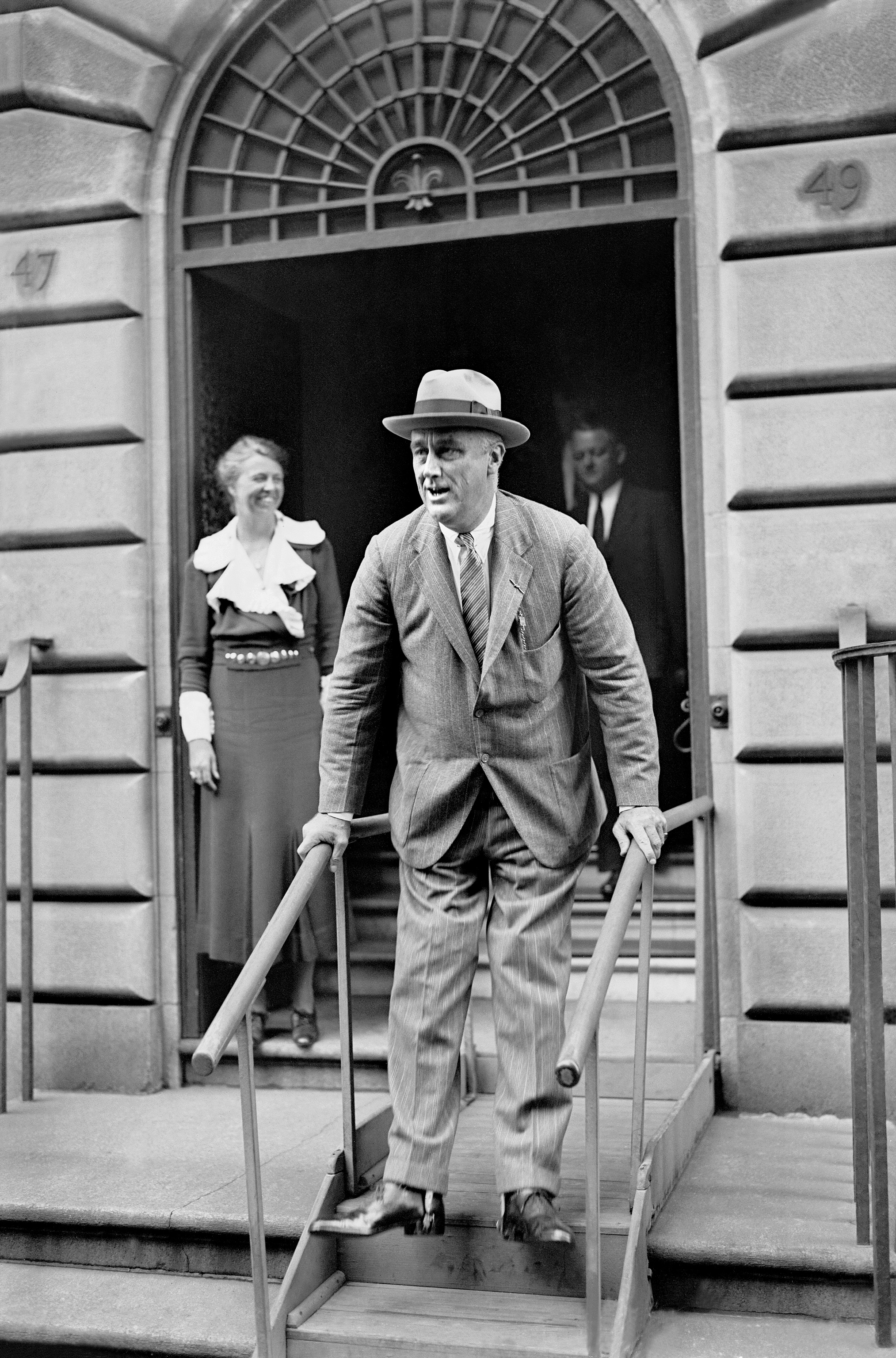
You can still see the ramps and rails at Franklin Roosevelt’s house on East 65th Street in Manhattan—even though they’ve been gone for decades. They’re easily visible in the pictures that decorate the home. They’re visible, too, in the popular iconography of Roosevelt, who was photographed standing countless times after being paralyzed by polio in 1921, but always with a hand on a bannister, an arm on an aide, a cane in his grip—and ramps and rails at the ready.
The six-story Roosevelt house, where the family lived from 1908 until their move to the White House in 1933, is now owned—and was restored—by New York’s Hunter College. These days it’s a place of learning and policy conferences. But it is also a place of historical serendipity.
“When the house was built, it was one of the first private residences in New York that had its own elevators,” Hunter president Jennifer Raab told me as we toured the building this morning. Those became indispensable once FDR became paralyzed, and it was in that house that his kitchen cabinet thus gathered in the four months between his election in 1932 and his inauguration 1933. “The New Deal was born here,” Raab says.
For FDR, there were abundant compensations for polio. As Ken Burns’ documentary The Roosevelts makes clear, the disease deepened and grounded him. It made him a champion of children with polio—an effort that led to the March of Dimes and the later Salk and Sabin vaccines—and for that matter a champion of all people who suffered hardship. It was polio that gave Roosevelt a fuller temperament—and in turn gave the nation a fuller Roosevelt.
There are no such compensations for the handful of children around the world who still contract the crippling disease. On the same morning I was making my visit to the Roosevelt house, word came out of Pakistan that the country is on target to top 200 polio cases in 2014, its biggest caseload since 2000. Pakistan is one of only three countries in the world where polio remains endemic—the other two are Afghanistan and Nigeria, with 10 and six cases respectively so far this year—and it’s the only one in which the caseloads are moving in the wrong direction.
As recently as 2005, Pakistan’s case count was down to just 28, helping to push polio to the brink of eradication. That same year, however, religious leaders in northern Nigeria declared a boycott of the vaccine, claiming that it contained HIV and was intended to sterilize Muslim girls. This led to a wildfire spread of the Nigerian strain that stretched as far southeast as Indonesia.
But Nigeria got its house in order, and the hot zone now—a more challenging one—has shifted to Pakistan, particularly in the tribal areas in the north and in the mega-city of Karachi. Some of the problem is simply the crowded, unhygienic conditions in Karachi. But the bigger piece is the fighting in the tribal regions, which have made vaccinations difficult or impossible. That’s been exacerbated by Taliban gunmen, who have shot and killed 59 polio field workers and police officers trying to protect them since 2012.
“It’s a very sad thing,” Aziz Memon, head of Rotary International’s PolioPlus team, told TIME by phone from Pakistan today. “We’re trying to get vaccinators on the ground and into the field despite the ban. And now rains and flooding that have broken 100-year-old records are creating more problems.”
Rotary, which has been the point-organization for the eradication of polio for more than 25 years, is being assisted by the Gates Foundation, Save the Children and multiple other international groups, all working to push back against the Taliban blockade. Vaccinators routinely wait at bus stops around Pakistan, climbing aboard and looking for kids who have no vaccination records and administering the drops on the spot. Refugee camps in the war torn tribal regions provide another way of standing between the virus and the babies.
“When the virus is contained like this it’s a good opportunity to step in and control it,” says Memon. “We can also take advantage of the low-transmission season, which starts soon.”
The effort to snuff out polio altogether is more than merely the moral thing, it’s also the practical thing. Bill Gates repeatedly stresses that $1 billion spent per year over the next few years can save $50 billion of the next 20 years, money that would otherwise be spent treating polio and constantly fighting the brushfire war of vaccinating against outbreaks. Eliminate the disease for good and those costs go with it. What’s more, the delivery networks that are put in place to do the job can be easily repurposed to fight other diseases.
None of this long-range thinking makes a lick of difference to the 187 Pakistani children—or the 10 Afghanis or six Nigerians—who forever lost the use of their legs this year. They are paralyzed, as they will be for life. For them, there is no offsetting wealth, no townhouse with an elevator, no path to global greatness. There is only the disease—a pain FDR recognized and fought to fix. In Pakistan, that same fight is being waged today.
More Must-Reads from TIME
- Why Biden Dropped Out
- Ukraine’s Plan to Survive Trump
- The Rise of a New Kind of Parenting Guru
- The Chaos and Commotion of the RNC in Photos
- Why We All Have a Stake in Twisters’ Success
- 8 Eating Habits That Actually Improve Your Sleep
- Welcome to the Noah Lyles Olympics
- Get Our Paris Olympics Newsletter in Your Inbox
Write to Jeffrey Kluger at jeffrey.kluger@time.com